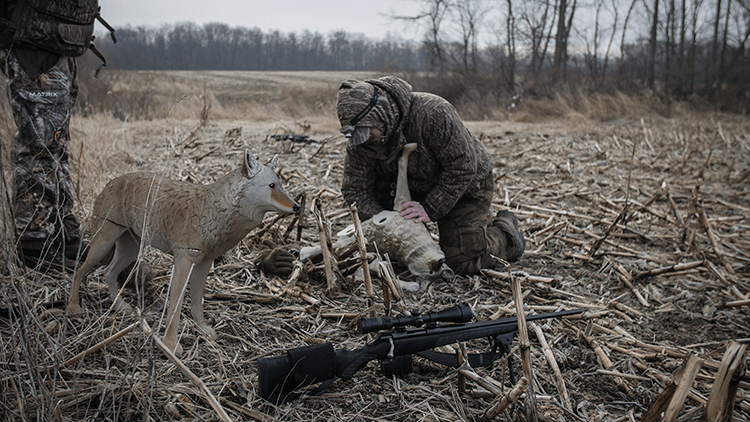by Taylor Michels |
Being a coyote hunter is like being in a fraternity. The first time you experience success calling or decoying one of these cagey creatures, a hunter can wear that memory like a badge of honor. Coyotes are one of Mother Nature’s most wide spread and effective predators. As a savage, top-end predator in the most wild landscapes in North America, coyotes are very adaptable and can be found in many urban settings as well. Like all categories of hunting, predator hunting has had many nuances added to the game in recent history. Decoying tactics is one nuance that has elevated many hunters from good to great. To be a great at decoying coyotes requires time in the field and some basic biological knowledge of your quarry. Here’s a few insights to help get you started on the path to successfully decoying impossible coyotes.
Basic knowledge is key
Key information, such as population density, den locations, and time of year, will source some predictable behavior and let you know if decoying is a viable option or not. December and January are the best time of year to integrate a decoy into your coyote calling tactics. During late summer and fall, most coyotes on the landscape are young-of-the-year animals. Only months in age under the protection and service of their adult caretakers, they haven’t gained the confidence to challenge other coyotes. Decoying early in the season will likely scare off most coyotes that aren’t willing to risk a fight or injury for a meal. When December rolls around, those same young pups are now older and tougher. Most realize by now that to survive they’ll have to sometimes fight for a meal. Decoying will breed competition, and competition breeds hunger—more likely this time of year to get the desired response. For the same reason, it is always best to stick to the areas where coyotes are plentiful. Coyotes in these areas will have no patience when they come to chase off your unwelcome protester. You can find out where the coyotes are by scouting yourself or communicating with landowners in the area. Getting in touch with local game and fish biologists can also provide great information on where to begin your efforts.
Be a glutton for punishment
Many of you will smile when you read this, but it is the truth. Predator hunting requires more trial and error than almost all other hunting opportunities combined. Time and again, even the most accomplished predator hunters hike back to the truck empty handed. When you are first learning, don’t just buy a new decoy and take it with on every stand. Hunt with and without it. You’ll learn more about the difference in behavior and reaction to your calling when there is a decoy present versus when there isn’t. A coyote decoy usually doesn’t provoke a hard charge—it is more of a calculated approach to the intruder. You can predict them to come down wind, so adding scent to your decoy will be crucial in most cases. So often, these wild predators will come in a very sly fashion and never really stop long enough to get a clean shot. Awkward shots happen all the time in coyote hunting. Effective decoying tactics allow you to better predict the path that animal will take into the area. Setup accordingly, and while the target animal is preoccupied with your decoy, you will have just enough time to get set up and comfortable for a steady, clean shot.

Decoy selection is crucial
Get the most realistic looking decoy you can afford. Coyotes have unbelievable senses, including eyesight, and are not easily fooled. Put your money into something that looks real like the Masters Series “Lone Howler” from Flambeau Outdoors. The faux-fur tail is poseable, which makes this decoy look perfect, even up close. If you plan to move often or hike long distances between stands, you’ll want something light to carry with adjustable features to give you added versatility to your setup. The Lone Howler does all of that.
At the end of the day there is no substitute for learning than days in the field. Go out and try it. Basic knowledge, effort afield, and the right decoy can get fool that dog that can’t be fooled. Good luck!